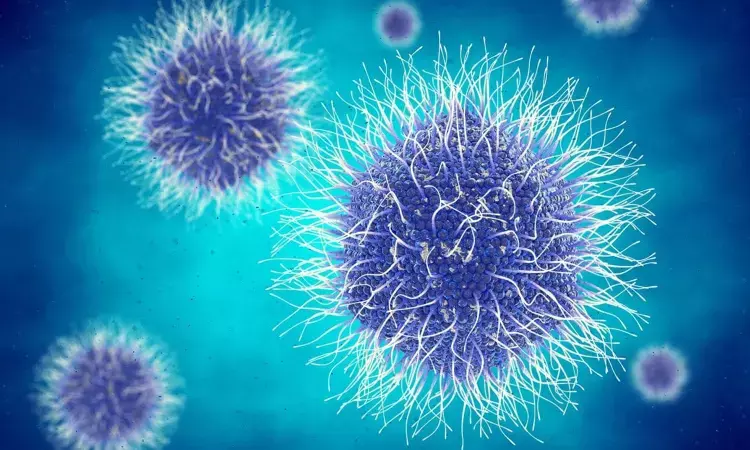- Home
- Medical news & Guidelines
- Anesthesiology
- Cardiology and CTVS
- Critical Care
- Dentistry
- Dermatology
- Diabetes and Endocrinology
- ENT
- Gastroenterology
- Medicine
- Nephrology
- Neurology
- Obstretics-Gynaecology
- Oncology
- Ophthalmology
- Orthopaedics
- Pediatrics-Neonatology
- Psychiatry
- Pulmonology
- Radiology
- Surgery
- Urology
- Laboratory Medicine
- Diet
- Nursing
- Paramedical
- Physiotherapy
- Health news
- Fact Check
- Bone Health Fact Check
- Brain Health Fact Check
- Cancer Related Fact Check
- Child Care Fact Check
- Dental and oral health fact check
- Diabetes and metabolic health fact check
- Diet and Nutrition Fact Check
- Eye and ENT Care Fact Check
- Fitness fact check
- Gut health fact check
- Heart health fact check
- Kidney health fact check
- Medical education fact check
- Men's health fact check
- Respiratory fact check
- Skin and hair care fact check
- Vaccine and Immunization fact check
- Women's health fact check
- AYUSH
- State News
- Andaman and Nicobar Islands
- Andhra Pradesh
- Arunachal Pradesh
- Assam
- Bihar
- Chandigarh
- Chattisgarh
- Dadra and Nagar Haveli
- Daman and Diu
- Delhi
- Goa
- Gujarat
- Haryana
- Himachal Pradesh
- Jammu & Kashmir
- Jharkhand
- Karnataka
- Kerala
- Ladakh
- Lakshadweep
- Madhya Pradesh
- Maharashtra
- Manipur
- Meghalaya
- Mizoram
- Nagaland
- Odisha
- Puducherry
- Punjab
- Rajasthan
- Sikkim
- Tamil Nadu
- Telangana
- Tripura
- Uttar Pradesh
- Uttrakhand
- West Bengal
- Medical Education
- Industry
PTE in Covid 19 due to thromboembolism or pulmonary artery thrombosis??

Pulmonary thromboembolism seen in COVID 19 patents is mainly pulmonary artery thrombosis rather than thromboembolism, finds a recent study in Italy. The study was published in the journal, Radiology: Cardiothoracic imaging 2020.
COVID 19 is caused by SARS-CoV-2 virus. The standard diagnosis for it is Real-time reverse transcription polymerase chain reaction (RT-PCR) but CT imaging is of great help in the early detection, in the differentiation among clinical stages, and to monitor the disease progression.
Also Read: COVID Cure: DCGI approves Itolizumab for restricted emergency use
Researchers from the dept. of Radiology, Rimini, Italy investigated CT pulmonary angiography (CTPA) findings of PTE in COVID-19 and its association with clinical and radiological conditions. The study was a retrospective study conducted on 109 hospitalized patients with COVID-19 who underwent CTPA for suspected PTE from March 20 to May 3, 2020. Based on the presence or absence of PTE, patients were divided in two groups. Their clinical and radiological conditions were compared using Mann-Whitney U test and χ2 test.
The key findings of the study were:
- Study population comprised 82M/19F, mean age 64.1±15.0 years.
- CTPAs were performed 19.8±6.1 days after the symptom onset and 10.5±3.8 days after the admission.
- Patients with PTE were 41/101(40.6%).
- PTE was mostly bilateral or only right (37/41[90.2%]), mainly involved segmental (37/41[90.2%]) or subsegmental (25/41[61.0%]) arteries, and affected mainly the lower lobes branches (30/41[73.2%]).
- Parenchymal segments supplied by segmental arteries with PTE showed a prevalent consolidation pattern (25/37[67.6%]).
- Deep vein thrombosis (DVT) was present only in 5/41(12.2%).
- Comparing groups with and without PTE, no significant difference was observed in age, gender, onset symptoms, comorbidities, tumor history, use of respiratory supports, activated partial thromboplastin time, prothrombin time and DVT.
- Conversely, differences were evaluated in CT lesion score (p=0.035); d-dimer (p<0.001); lactate dehydrogenase (LDH) (p<0.001), and C-reactive protein (CRP) (p=0.042). Patients with more severe COVID-19 lung disease (higher CT lesion score, d-dimer, LDH and CRP) tend to be more affected by PTE.
Thus, the authors concluded that PTE in COVID-19 involves mainly the segmental and sub-segmental arteries of segments affected by consolidations in patients with more severe lung disease. They also hypothesized that the development of PTE in COVID-19 might be a pulmonary artery thrombosis due to severe lung inflammation and hypercoagulability rather than thromboembolism.
For further reading, click the following link: https://doi.org/10.1148/ryct.2020200289
BDS, MDS
Dr.Niharika Harsha B (BDS,MDS) completed her BDS from Govt Dental College, Hyderabad and MDS from Dr.NTR University of health sciences(Now Kaloji Rao University). She has 4 years of private dental practice and worked for 2 years as Consultant Oral Radiologist at a Dental Imaging Centre in Hyderabad. She worked as Research Assistant and scientific writer in the development of Oral Anti cancer screening device with her seniors. She has a deep intriguing wish in writing highly engaging, captivating and informative medical content for a wider audience. She can be contacted at editorial@medicaldialogues.in.
Dr Kamal Kant Kohli-MBBS, DTCD- a chest specialist with more than 30 years of practice and a flair for writing clinical articles, Dr Kamal Kant Kohli joined Medical Dialogues as a Chief Editor of Medical News. Besides writing articles, as an editor, he proofreads and verifies all the medical content published on Medical Dialogues including those coming from journals, studies,medical conferences,guidelines etc. Email: drkohli@medicaldialogues.in. Contact no. 011-43720751


